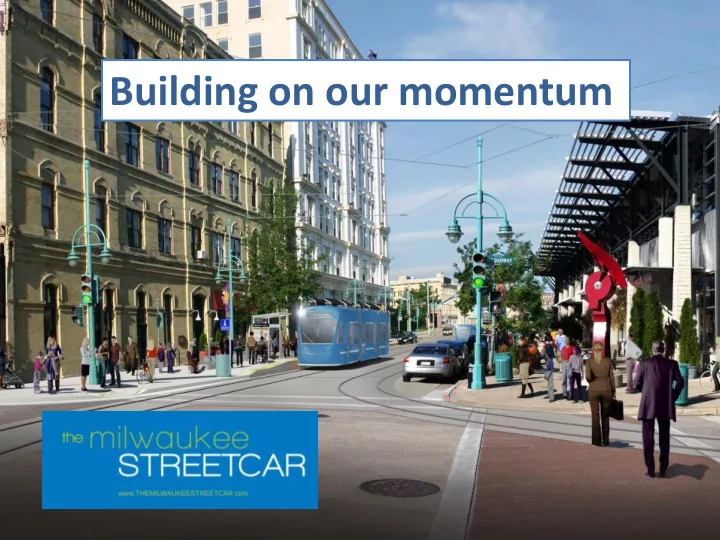

Building on our momentum
Building on our momentum
Three questions 1. Why this? 2. Why downtown? 3. Why now? Toronto
Why a modern streetcar?
Why? Investment and growth along and near the route.
Why? Attract and retain business and talent.
Why? Millennials are less likely to own cars. They demand transit alternatives, prefer fixed transit.
Attitudes/location preferences of young adults The Young and Restless: • 25 to 34 year olds with a bachelor’s degree or higher level of education, • Increasingly moving to the close-in neighborhoods of the nation’s large metropolitan areas • This migration is fueling economic growth and urban revitalization.
Attitudes and location preferences of young adults Change in Young and Restless in Close-in Neighborhoods, by Metro
Why? Further establish Milwaukee as a world- class city that competes globally.
Why? Improve transportation/access Connect people to homes, jobs, attractions.
Why? Part of a comprehensive transportation strategy
Total Capital Budget for Core Infrastructure Programs 2004 - 2015 $90 $80 $70 $60 In Millions $50 $40 $30 $20 $10 $0 2004 2005 2006 2007 2008 2009 2010 2011 2012 2013 2014 2015
Local Paving Replacement Cycle Selected Years: 2004-2014 120 108 100 74 80 62 60 40 20 0 2004 2008 2014
Examples of infrastructure investments that led to economic development Commerce Street (Beerline) $1,800,568 Reflects just Commerce Street, not riverwalk or any other infrastructure . Canal Street (Menomonee Valley) $52 million
Why? 720+ jobs from streetcar construction
Why? Workforce development and training opportunities
Commitment to Diversity
Why? Employment from ongoing investment along the route
Why downtown?
Why downtown? Simply put: “A healthy downtown with a healthy tax base helps the entire city .” Milwaukee Journal Sentinel editorial
Why downtown? Expand throughout the community, but must start with the most successful route and highest possible ridership.
Why downtown? C.B.D. has: 80,000 workers 25,000 residents 5.5 million visitors annually = provides the strong start.
Why downtown? The starter route and initial extensions are within a 1/4-mile of: • 100% hotels • 90% occupied office • 90% occupied retail • 77% of parking • 77% of housing • 90% of major downtown attractions • 100% of downtown’s 20 largest employers
Examples of starter route lengths In Operation/Modern (cont’) In Operation/Modern Portland: Tucson: 2.4 miles/Phase I 3.9 miles/Phase I .6 miles/Riverplace Ext. .6 miles/Gibbs Ext. In Operation/Vintage .4 miles/Lowell Ext. 2.4 miles/ Tampa 4 miles/Eastside Loop 1 mile/ Kenosha Tacoma: 3.4 miles/ Little Rock 1.6 miles/Tacoma Link Under Construction Seattle: 1.3 miles/ Atlanta Phase I 1.3 miles/Phase I 2 miles/ Wash., D.C. Phase I 2 miles/Phase II
We have the density to support fixed transit: Fixed transit in the 40 most populated U.S. cities – 2013 Census Density Fixed transit Density Fixed transit 1 New York City 27,742 Yes 21 Las Vegas 4,437 Monorail 2 San Francisco 17,818 Yes 22 Denver 4,245 Yes 3 Boston 13,458 Yes 23 San Diego 4,172 Yes 4 Chicago 11,924 Yes 24 Arlington, TX 3,954 Yes 5 Miami 11,601 Yes 25 Columbus 3,791 In planning 6 Philadelphia 11,591 Yes 26 Dallas 3,688 Yes 7 Washington 10,598 Yes 27 Houston 3,660 Yes 8 Long Beach 9,389 Yes 28 Omaha 3,420 In planning 9 Los Angeles 8,282 Yes 29 Atlanta 3,367 Yes 10 Seattle 7,767 Yes 30 Mesa 3,365 In planning 11 Baltimore 7,680 Yes 31 San Antonio 3,056 No 12 Minneapolis 7,409 Yes 32 Raleigh 3,019 No 13 Oakland 7,255 Yes 33 Austin 2,971 Yes 14 Milwaukee 6,241 In planning 34 Albuquerque 2,960 Yes 15 San Jose 5,641 Yes 35 Phoenix 2,927 Yes 16 Cleveland 5,001 Yes 36 Charlotte 2,661 Yes 17 Detroit 4,955 Under Constr. 37 El Paso 2,645 No 18 Sacramento 4,895 Yes 38 Wichita 2,431 No 19 Portland 4,582 Yes 39 Indianapolis 2,336 Yes 20 Fresno 4,553 No 40 Fort Worth 2,332 Yes Density = Aver. population/square mile .
Why now?
Why now? We have the funding and, hopefully, civic and political will. Costs Amount Maintenance Facility $7.5 m 4 Vehicles $17.6 m Phase 1: Blue Line Tracks/Stops/Systems $73.8 m Phase 2: Lakefront Tracks/Stops/Systems $25.0 m Total Costs $123.9 m Sources Amount Federal: ICE Funding (Existing) $54.9 m Federal: TIGER application (New) $10.0 m Local: Cathedral Square TID (Existing) $9.7 m Local: Amend Erie St. TID 56 to 19 years (New) $18.3 m Local: East Michigan TID @ 19 years (New) $31.0 m Total Source of Funds $123.9 m
Why now? Project held up by utility issue. State law exists – although under appeal – we are moving ahead.
Why now? New lakefront line connects new developments in that area and across downtown.
Why now? Milwaukee Journal Sentinel editorial: “Milwaukee has a choice to make, and it shouldn't be a hard one: Remain a transport backwater or get on board along with many other cities that understand the benefits of a modern system. We support a streetcar line for downtown.” Milwaukee Business Journal editorial: “But if Milwaukee finally wants to do something to improve its public transportation system, aldermen need to approve Barrett's request and finally get the project underway. The streetcar is not the only way to improve the region's transit system, but, as we have said before, it is a good first step and has been successful in other cities.” Milwaukee Magazine Kurt Chandler (about a downtown boom): “So here’s to bold ideas. We’re hoping the city leaders have learned from past mistakes and can overcome their long-held aversion to taking calculated risks.”
Next Steps • Ongoing Public Outreach • Vehicle Selection - 2015 • Final Design - 2015 • Construction – 2015-2017 • Streetcar Operations – 2018
Thank you
Recommend
More recommend